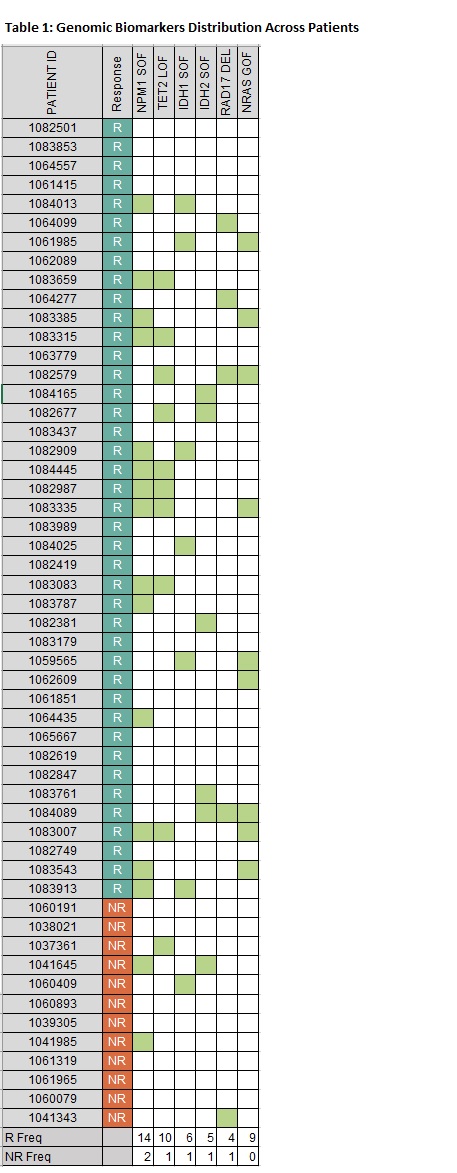Abstract
Background: The optimal treatment strategy for managing Acute Myeloid Leukemia (AML) and the use of reliable and predictive biomarkers to guide selection of cytotoxic chemotherapy regimens among patients with diverse genomic profiles remain unmet needs in the clinic. The combination of MEC [mitoxantrone (MIT), etoposide (VP16), and cytarabine (ARA-C)] is a commonly used regimen for relapsed or refractory AML patients. Unfortunately, many patients do not respond to MEC, and which of the three drug agents matters most for each individual patient is not known. Predictors of response are needed urgently.
Methods: The Computational Omics Biology Model (CBM) is a computational multi-omic biology software model created using artificial intelligence heuristics and literature sourced from PubMed to generate a patient-specific protein network map. The aberration and copy number variations from individual cases served as input into the CBM. Disease-biomarkers unique to each patient were identified within patient-specific protein network maps. Biosimulations were conducted on the Cellworks Biosimulation Platform by measuring the effect of chemotherapy on a cell growth score comprised of a composite of cell proliferation, viability, apoptosis, metastasis, and other cancer hallmarks. Biosimulation of drugs was conducted by mapping the interaction of various drug combinations with the patient's genomic and pathway alterations based on signaling pathway mechanisms and their phenotypic consequences.
The Cellworks Biosimulation Platform identified unique chromosomal signatures that permit a stratification of patients that are most likely to respond to MIT, VP16, or ARA-C as well as their combinations.
65 AML patients were selected for this study largely based on genomic data published in TCGA and PubMed:
ARA-C [N=12, 7 responders (R) & 5 non-responders (NR)]
ARA-C + MIT [N=30, 29 R & 1 NR]
ARA-C + MIT + VP16 [N=23, 12 R & 11 NR]
Results: Of the12 patients treated with ARA-C alone, 5 were predicted to be NR and 7 were predicted to be R. Of the 5 NR, 4 had 5q del which resulted in loss of APC, CSNK1A1 and SLC22A4 (nucleoside carrier) forming the non-response biomarkers for ARA-C. Notably, the biosimulation predicted lenalidomide to be beneficial for these patients. Out of 7 R, 4 patients also had 5q del, but were predicted to be R because of co-occurring aberrations involving CLSPN del, DHODH del, MSH2 del, EP300 del, CREBBP del, MSH6 Del, and RRM2 del. These genes were exclusively present in ARA-C responders. Of 53 patients who received ARA-C + VP16 + MIT or ARA-C + MIT, 41 patients were predicted to be R and 12 patients were predicted to be NR. The genomic aberrations predicted by biosimulation to be associated with response to this regimen include: NPM1-mut, TET2-mut, IDH1-mut, IDH2-mut, RAD17-del, NRAS-mut (Table 1). Notably, CBM predicted 19 of the 41 R had no genomic biomarkers of response to VP16 or MIT, suggesting these patients might have benefited equally from ARA-C alone with less toxicity and cost. Finally, 11/65 patients were predicted NR to MEC treatment. In the biosimulation, treatment failure was associated with high aberration frequencies of KMT2C-mut/del, FLT3 mut, TWIST1 del, LIMK1 del, SNAI2 amp, FNTA amp, and KAT6A amp. Of note, these genomic markers suggested a likelihood of benefit from other therapies, including vincristine, JQ1 and rigosertib.
Conclusions: The Cellworks Biosimulation Platform identified novel polygenic biomarkers of response that can be employed to determine the optimal therapy for relapsed AML patients. Biosimulation permits avoidance of cytotoxic drugs with little chance of efficacy and reveals vulnerabilities in each patient's cancer that can be exploited to improve disease control. In AML, biosimulation promises to improve intensive therapy regimens by tailoring chemotherapy to optimize disease control and minimize toxicity.
Marcucci: Novartis: Other: Speaker and advisory scientific board meetings; Agios: Other: Speaker and advisory scientific board meetings; Abbvie: Other: Speaker and advisory scientific board meetings. Kumar: Cellworks Group Inc.: Current Employment. Castro: Cellworks Group Inc.: Current Employment; Omicure Inc: Consultancy; Caris Life Sciences Inc.: Consultancy; Exact sciences Inc.: Consultancy; Bugworks: Consultancy; Guardant Health Inc.: Speakers Bureau. Grover: Cellworks Group Inc.: Current Employment. Patil: Cellworks Group Inc.: Current Employment. Alam: Cellworks Group Inc.: Current Employment. Azam: Cellworks Group Inc.: Current Employment. Mohapatra: Cellworks Group Inc.: Current Employment. Tyagi: Cellworks Group Inc.: Current Employment. Kumari: Cellworks Group Inc.: Current Employment. Prasad: Cellworks Group Inc.: Current Employment. Nair: Cellworks Group Inc.: Current Employment. Lunkad: Cellworks Group Inc.: Current Employment. Joseph: Cellworks Group Inc.: Current Employment. G: Cellworks Group Inc.: Current Employment. Chauhan: Cellworks Group Inc.: Current Employment. Basu: Cellworks Group Inc.: Current Employment. Behura: Cellworks Group Inc.: Current Employment. Ghosh: Cellworks Group Inc.: Current Employment. Husain: Cellworks Group Inc.: Current Employment. Mandal: Cellworks Group Inc.: Current Employment. Raman: Cellworks Group Inc.: Current Employment. Patel: Cellworks Group Inc.: Current Employment. Mundkur: Cellworks Group Inc: Current Employment. Christie: Cellworks Group Inc.: Current Employment. Macpherson: Cellworks Group Inc.: Current Employment. Howard: Servier: Consultancy; Cellworks Group Inc.: Consultancy; Sanofi: Consultancy, Other: Speaker fees.


This feature is available to Subscribers Only
Sign In or Create an Account Close Modal